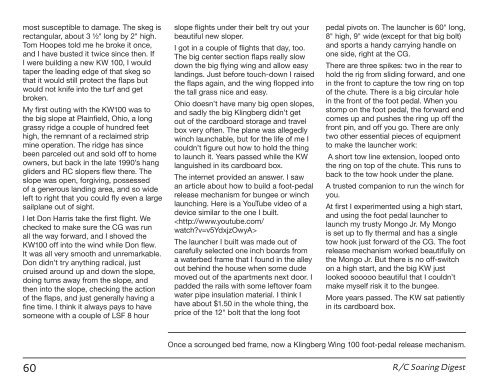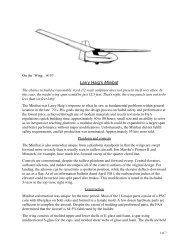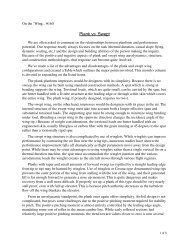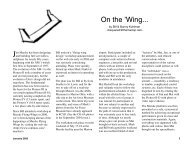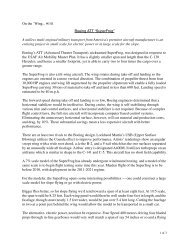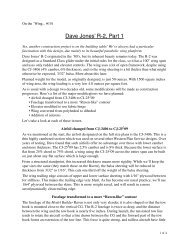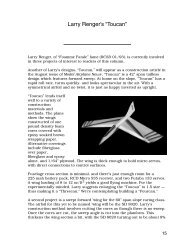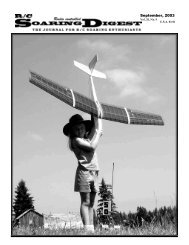Oct - Rcsoaring.com
Oct - Rcsoaring.com
Oct - Rcsoaring.com
- No tags were found...
You also want an ePaper? Increase the reach of your titles
YUMPU automatically turns print PDFs into web optimized ePapers that Google loves.
most susceptible to damage. The skeg isrectangular, about 3 ½" long by 2" high.Tom Hoopes told me he broke it once,and I have busted it twice since then. IfI were building a new KW 100, I wouldtaper the leading edge of that skeg sothat it would still protect the flaps butwould not knife into the turf and getbroken.My first outing with the KW100 was tothe big slope at Plainfield, Ohio, a longgrassy ridge a couple of hundred feethigh, the remnant of a reclaimed stripmine operation. The ridge has sincebeen parceled out and sold off to homeowners, but back in the late 1990’s hanggliders and RC slopers flew there. Theslope was open, forgiving, possessedof a generous landing area, and so wideleft to right that you could fly even a largesailplane out of sight.I let Don Harris take the first flight. Wechecked to make sure the CG was runall the way forward, and I shoved theKW100 off into the wind while Don flew.It was all very smooth and unremarkable.Don didn’t try anything radical, justcruised around up and down the slope,doing turns away from the slope, andthen into the slope, checking the actionof the flaps, and just generally having afine time. I think it always pays to havesomeone with a couple of LSF 8 hourslope flights under their belt try out yourbeautiful new sloper.I got in a couple of flights that day, too.The big center section flaps really slowdown the big flying wing and allow easylandings. Just before touch-down I raisedthe flaps again, and the wing flopped intothe tall grass nice and easy.Ohio doesn’t have many big open slopes,and sadly the big Klingberg didn’t getout of the cardboard storage and travelbox very often. The plane was allegedlywinch launchable, but for the life of me Icouldn’t figure out how to hold the thingto launch it. Years passed while the KWlanguished in its cardboard box.The internet provided an answer. I sawan article about how to build a foot-pedalrelease mechanism for bungee or winchlaunching. Here is a YouTube video of adevice similar to the one I built.The launcher I built was made out ofcarefully selected one inch boards froma waterbed frame that I found in the alleyout behind the house when some dudemoved out of the apartments next door. Ipadded the rails with some leftover foamwater pipe insulation material. I think Ihave about $1.50 in the whole thing, theprice of the 12" bolt that the long footpedal pivots on. The launcher is 60" long,8" high, 9" wide (except for that big bolt)and sports a handy carrying handle onone side, right at the CG.There are three spikes: two in the rear tohold the rig from sliding forward, and onein the front to capture the tow ring on topof the chute. There is a big circular holein the front of the foot pedal. When youstomp on the foot pedal, the forward end<strong>com</strong>es up and pushes the ring up off thefront pin, and off you go. There are onlytwo other essential pieces of equipmentto make the launcher work:A short tow line extension, looped ontothe ring on top of the chute. This runs toback to the tow hook under the plane.A trusted <strong>com</strong>panion to run the winch foryou.At first I experimented using a high start,and using the foot pedal launcher tolaunch my trusty Mongo Jr. My Mongois set up to fly thermal and has a singletow hook just forward of the CG. The footrelease mechanism worked beautifully onthe Mongo Jr. But there is no off-switchon a high start, and the big KW justlooked sooooo beautiful that I couldn’tmake myself risk it to the bungee.More years passed. The KW sat patientlyin its cardboard box.Once a scrounged bed frame, now a Klingberg Wing 100 foot-pedal release mechanism.60 R/C Soaring Digest


